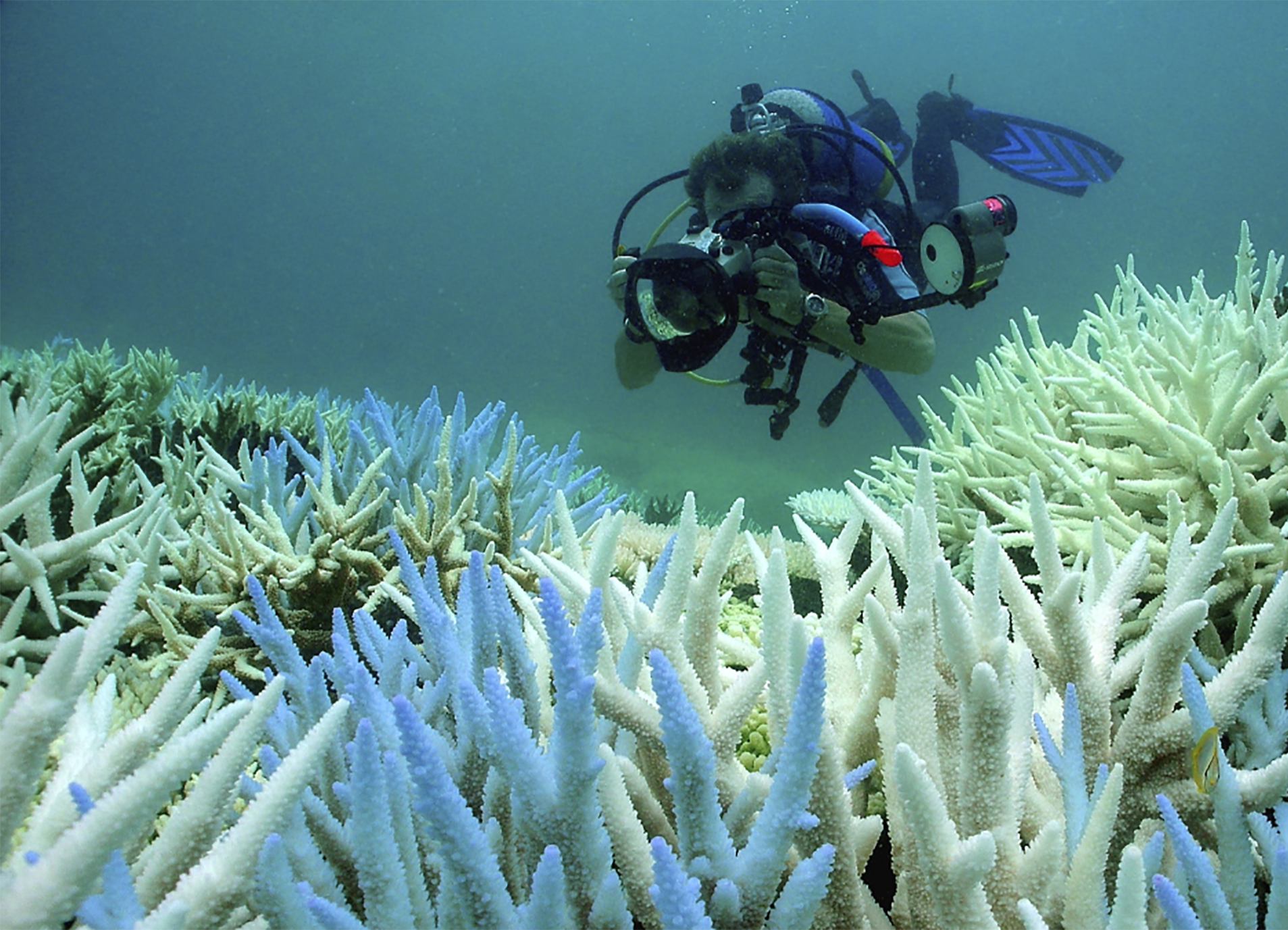Mass Bleaching
Coral bleaching is a common response of a coral under stress, and isolated colonies or small patches of bleached coral are not necessarily cause for concern. However, mass bleaching events that span tens or even hundreds (and sometimes thousands) of kilometers can affect entire ecosystems and are a significant cause for concern for coral reef managers and stakeholders.
Mass bleaching events are primarily triggered by sea temperatures exceeding the normal summer maximum for prolonged periods (weeks). The frequency and severity of mass-bleaching events have been increasing over the last few decades, causing reef degradation at a global scale. These events are expected to occur even more often as sea-surface temperatures continue to rise under global climate change. ref

Mass bleaching event in the Keppel Islands, Australia. Photo © Paul Marshall/Great Barrier Reef Marine Park Authority
Bleaching severity can vary across a reef system, even within a mass bleaching event. A range of factors will influence the timing and severity of bleaching, especially at the scale of individual reefs or areas. While high water temperature and bright sunlight are the primary triggers of mass bleaching, calm and clear conditions with minimal current can exacerbate the stress and intensify bleaching. Lack of wind and currents may result in less mixing of water layers, clearer seas, and deeper penetration of solar irradiance (i.e., the amount of light that penetrates the water column).

Map of the distribution of coral bleaching globally. Prevalence of coral bleaching is presented as a percentage of the coral assemblage that bleached at 3,351 sites in 81 countries from 1998 to 2017. White circles indicate no bleaching. Colored circles indicate 1% bleaching (blue) through 100% bleaching (yellow). Source: Sully et al. 2019
The response of a coral community to stress also depends on the condition (pre-existing stressors) of corals and the abundance and composition of corals. Reefs dominated by resistant coral types may bleach less severely, or bleach later, than reefs dominated by susceptible species. Factors that reduce these stressful conditions, such as cloud cover, strong winds, or tropical storms may be enough to protect the corals from bleaching.
Forecasting Mass Bleaching Events
Whether a reef bleaches during warming events depends on a variety of factors, both physical and biological. However, the strong link to temperature provides a reliable basis for predicting the probability and timing of mass bleaching events.
Degree heating weeks (DHWs) are a metric used by NOAA’s Coral Reef Watch program to help coral reef managers worldwide monitor bleaching risk. Because coral bleaching risk is determined by both the size of the temperature anomaly and its duration (i.e., how far the temperature is above the bleaching threshold and how long it has stayed above that threshold), DHWs are used to represent the accumulation of thermal stress for corals. One DHW is equivalent to one week of sea-surface temperatures one degree Celsius greater than the expected summertime maximum. Two DHWs are equivalent to two weeks at one degree above the expected summertime maximum or one week of two degrees above the expected summertime maximum. At 4 DHWs, conditions have become stressful for corals, and bleaching events become likely. Severe stress and possibly mortality is likely to occur at 8 DHWs or greater.
A recent report by the United Nation Environment Programme (UNEP) used the latest climate model from the IPCC to update global and regional projections of the onset of Annual Severe Bleaching (ASB) among the world’s coral reefs. A key result from the report is that the majority of coral reefs (>80%) are expected to experience ASB this century, even considering climate adaptation. Projections from the report can also be used in coral reef management and planning by informing the likeliness and timing at which a reef or reef area will be impacted by severe coral bleaching. Global map images are presented on UNEP’s World Environment Situation Room and data layers that are compatible with use in ArcGIS can be downloaded.
The Allen Coral Atlas has launched a satellite-imagery-based global monitoring system for coral reefs, bringing new hope to conservation efforts. To learn more, view the 5-minute video below that shows how the Atlas bleaching monitoring system works, how to visualize it, and how you can help the validation process.
Click here for information on monitoring and managing bleaching events.
